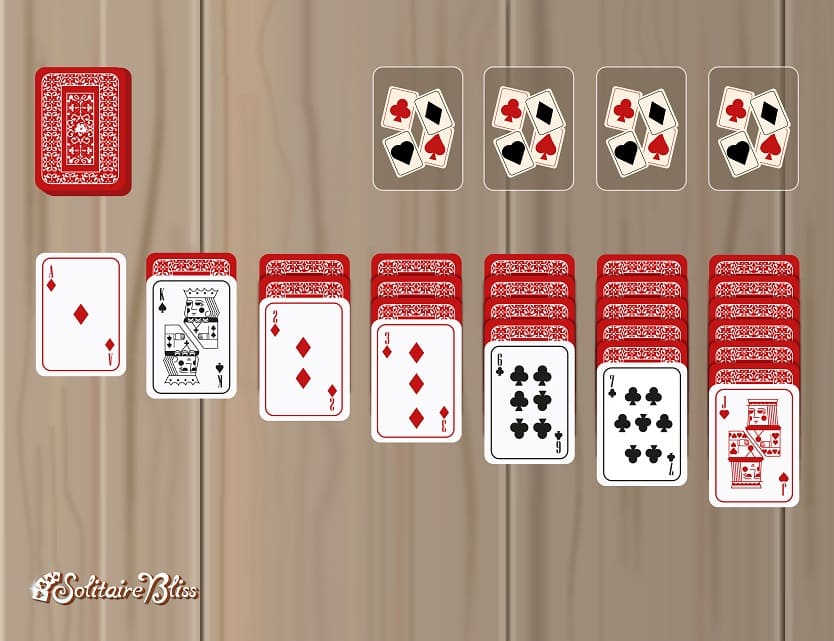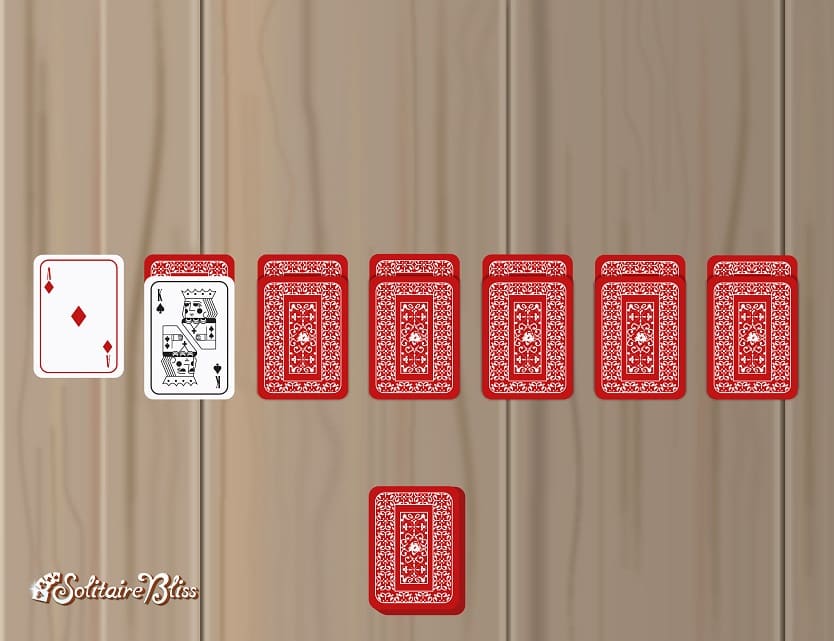How to Set Up Solitaire

Classic Solitaire, also known as Klondike Solitaire, is a popular single-player card game with several variations. This post shows you the step-by-step process for setting up Classic Solitaire while introducing basic Solitaire terms, moves, and variations to get you ready to play. To start playing the Solitaire card game, you just need a standard deck of cards (or the electronic version) and yourself!
Key Solitaire terms
- Tableau: The French word for “table,” tableau refers to the main playing area where you lay out your cards. The tableau layout consists of cards dealt in seven columns at the start of the game.
- Stockpile: After dealing the cards onto the tableau, the remaining cards left in the stack make up the stockpile. You draw cards from the stockpile to play them during the game.
- Talon pile: When you cannot play a card drawn from the stockpile, you place it in the talon pile (also known as the waste pile). You can use cards from the talon, or waste pile during gameplay.
- Foundation piles: You win classic Solitaire by filling up the foundation piles above the tableau. Each foundation pile corresponds to one of the four suits (spades, hearts, clubs, and diamonds). After starting a foundation pile with an ace of any suit, you continue adding cards of the same suit in ascending order: 2, 3, 4, 5, 6, 7, 8, 9, 10, jack, queen, then king. To win Solitaire, you will have four completed foundation piles, known as “families”.

Step 1: Deal seven cards in a row with the first facing up.
After shuffling a deck of 52 cards, begin a Solitaire round by creating the initial tableau: Deal seven cards in a row from left to right with the first card face up and the others face down. You should then have a row of seven cards across, with only the card on the far left facing up. These seven cards form the basis of your columns.

Step 2: Starting on the second column, deal six cards.
Repeat the pattern above, starting with the second card from the left. Deal one card face up on the second column and one card face down on each of the remaining five columns.

Step 3: Starting on the third column, deal five cards.
Skipping the first and second columns, deal one face-up card on the third pile and then one face-down card on piles four through seven. After dealing this round, you should have three columns topped with face-up cards and four columns of face-down cards.

Step 4: Starting on the fourth column, deal four cards.
Deal four more cards starting with a face-up card on the fourth column and a face-down card on each of the remaining three columns. You should end up with four columns topped with face-up cards to the left and three columns of face-down cards to the right.

Step 5: Starting on the fifth column, deal three cards.
Beginning with the fifth column, deal one face-up card followed by a face-down card on columns six and seven. After this deal, you should have five columns topped with face-up cards and two columns of face-down cards.

Step 6: Starting on the sixth column, deal two cards.
Deal two cards in this round: a face-up card on the sixth column and a face-down card on the seventh column. At this point, only the last column will have a face-down card on top.

Step 7: Deal the final card face up.
To finalize your tableau, deal the last card face up on the seventh column. At this point, you should have an upside-down staircase towards the right, with each column one card longer than the column to the left and with each column having a face-up card visible.

Step 8: Place the stockpile above the tableau.
The 24 cards that remain after you set up your tableau constitute your stockpile. Place the stockpile in a stack above the tableau on the left-hand side. During the course of the game, you will draw cards from this stockpile and attempt to play them in your Solitaire tableau or on foundation piles. When you can no longer play a card from the stockpile, you may place it face up in the waste pile to the right of the stockpile.

Step 9: Create a space for your foundation piles.
Create a space—generally above the tableau and to the right in Classic Solitaire—for your foundation piles. You need room for four piles of cards, one for a foundation pile for each suit. Eventually, you will have two red piles (hearts and diamonds) and two black piles (clubs and spades).

Step 10: Begin playing

As soon as you set up your tableau, you can start moving your playing cards by following these Solitaire rules and strategies:
- See if you can start your four foundation piles. If you see an ace of any suit face up in your main tableau, move it to begin a foundation pile. After moving any face-up aces from your tableau to a foundation pile, turn over the card underneath to find out if it’s another card you can move to a foundation pile. Continue to build foundation piles throughout the game in ascending order from ace to king with cards of the same suit. So if you move the ace of hearts to its foundation pile and a 2 of hearts is also face up, you can move the 2 of hearts on top of the ace of hearts.
- Rearrange your face-up cards. Face-up column cards should be arranged in descending order by opposite color so that the colors alternate through the column. In other words, you can move a red 8 of diamonds to a black 9 of spades, and then a black 7 of clubs on top of the red 8 of diamonds. Don’t forget to stagger the cards slightly so you can see the whole column at once. To save time, you don’t need to move cards one by one: You can lift ordered stacks of face-up cards (like the 9 of spades, 8 of diamonds, and 7 of clubs) and move them to their proper place (like on top of a 10 of hearts). Since each column should always have at least one card face up, you may need to turn a card over whenever you remove a face-up card or column of cards. Finally, keep an eye on your foundation piles: Each time you flip over a face-down card, you have a new chance to build your foundation piles.
- If there’s an empty tableau column, you can start a new column beginning with a king only. As you move cards around your tableau, you may end up with an empty column. When that happens, you can start a new column—but only when you have a king. You can move face-up kings (or columns that begin with a king) from your tableau to the empty space or start a new column when you draw a king from the stockpile.
- You may need to draw additional cards from the stockpile. When you cannot move any cards between columns or to the foundation piles, you can draw from the stockpile to make additional moves. Some versions of Solitaire have you draw one card at a time, while others have you draw three. In the latter version, if you use the top card in your stack of three, you can use the second and then the last. When you can’t use a card or stack of cards, you discard them face up into your waste pile. The face-up card on your waste pile can always be played at any time like any other face-up card, so don’t forget to check your waste pile while playing. Using the waste pile card means new cards get revealed underneath. When your stockpile runs out, simply turn over your waste pile and make it the new stockpile, but you cannot shuffle the waste pile.
- Move all of the cards to their correct suits in the foundation piles. A winning game of Solitaire occurs when you move all the cards in the deck to their correct foundation pile by suit in ascending order. In other words, when you have one pile of hearts, one of clubs, one of spades, and one of diamonds—all stacked in order with an ace on the bottom and a king on the top—you win!
Set up for popular Solitaire versions
The possible versions of this famous single-player game are limited only by the imagination—by some estimations, over 500 Solitaire variations already exist. We’ve listed the most popular Solitaire games below, along with how the card layouts may differ from Classic Solitaire:
- Spider: Spider Solitaire uses two decks of cards dealt into 10 columns in the tableau. Six cards each go into the first four columns and five cards each go into the other six columns, for a total of 54 cards in the initial tableau. The 50 cards that remain go into the stockpile. You move cards to make columns in descending order from king to ace.
- FreeCell: Like Classic Solitaire,FreeCell Solitaire uses one standard 52-card deck.Unlike Classic Solitaire, however, the main tableau consists of eight columns of cards all dealt face up. The first four columns have seven cards each and the last four columns have six cards each. You get four “free” cells that you can use to move individual cards into, making other moves possible.
- Yukon: Yukon Solitaire looks very similar to Classic Solitaire, except Yukon requires players to deal all 52 cards into the tableau. After dealing 21 cards face down, deal the remaining cards face up, one into the first column and five each into the other six columns.
- Golf: For the main tableau, Golf Solitaire requires five face-up cards in each of seven columns and a single face-up card in the foundation. Place the rest of the cards face down in the stock. The only moves you make are to move a card from the tableau to the foundation card or draw from the stockpile to create a new foundation card.
- Pyramid: As the name suggests, Pyramid Solitaire begins with rows of cards placed in a pyramid shape. You deal cards face up in overlapping rows, starting with one card in the first row, two in the second, and so on until completing the final row of seven cards. The remaining cards go face down into the stockpile, and you can only remove exposed pairs of cards that add up to 13.
Ready to play?
Now that you know the layout and some of the basic moves for Classic Solitaire, you’re ready to get started. As you become familiar with the many different ways to play Solitaire, you can try different versions and pick the one you like to play the best.
Back to the Homepage



